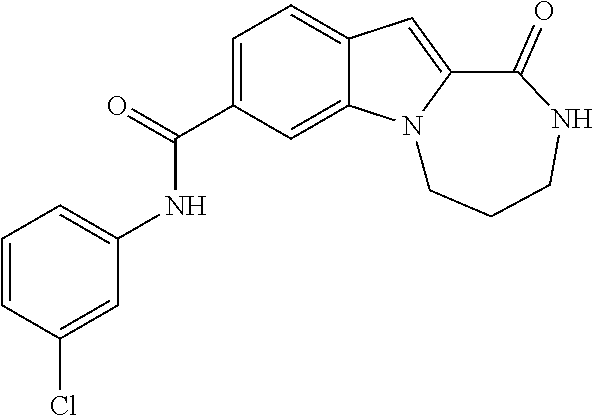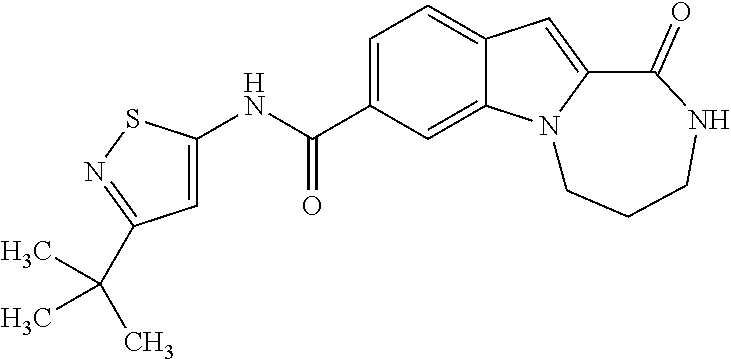Heterocyclic compounds containing an indole core
a technology of indole core and heterocyclic compounds, which is applied in the field of compounds, can solve the problems of not being approved for nhe1 inhibitors on the market, and impairing the physiological function of maintaining intracellularity
- Summary
- Abstract
- Description
- Claims
- Application Information
AI Technical Summary
Benefits of technology
Problems solved by technology
Method used
Image
Examples
example 1
N-(3-chlorophenyl)-1-oxo-2,3,4,5-tetrahydro-1H-[1,4]diazepino[1,2-a]indole-8-carboxamide
[0275]
[0276]To a solution of 1-oxo-2,3,4,5-tetrahydro-1H-[1,4]diazepino[1,2-a]indole-8-carboxylic acid (Intermediate J, 49 mg, 0.2 mmol) in DMF (1 mL) is added [(benzotriazol-1-yloxy)-dimethylamino-methylene]dimethyl-ammonium tetrafluoroborate (TBTU) (77 mg, 0.24 mmol) and the reaction is stirred for 10 minutes. The reaction is then treated with 3-chloro-phenylamine (28 mg, 0.22 mmol) followed by triethylamine (0.10 mL, 0.7 mmol) and is stirred for 16 h. The reaction is poured into water (20 mL) and the resulting solid is filtered. The solid is dried, suspended in MTBE (20 mL) and filtered again to afford the title compound (40 mg, 56%) as an off-white solid.
[0277]Examples 2-156 are synthesized according to the procedure for Example 1, substituting either commercially available reagents or the appropriate intermediates described above.
example 157
4,4-dimethyl-N-(5-methyl-1,2-oxazol-3-yl)-1-oxo-2,3,4,5-tetrahydro-1H-[1,4]diazepino[1,2-a]indole-8-carboxamide
[0278]
[0279]To a solution of 4,4-dimethyl-1-oxo-2,3,4,5-tetrahydro-1H-[1,4]diazepino[1,2-a]indole-8-carboxylic acid (100 mg, 0.37 mmol) in THF (2 mL) is added 1,1′-carbonyldiimidazole (149 mg, 0.92 mmol). The reaction mixture is heated at 55° C. for 1 h. The mixture is cooled to room temperature and 5-methyl-3-aminoisoxazole (144 mg, 1.47 mmol) is added. After stifling 10 min, 1,8-diazabicycloundec-7-ene (0.14 mL, 0.92 mmol) is added and the reaction is heated at 60° C. for 16 h. After cooling to room temperature, the solvent is evaporated and the residue is purified by preparative HPLC using 10-85% acetonitrile / water with 0.1% TFA to afford the title compound (79 mg, 61%). LCMS (ESMS): m / z 353.45 (M+H+).
[0280]Examples 158-173 are synthesized according to the procedure for Example 157, substituting either commercially available reagents or the appropriate intermediates desc...
example 174
4-methyl-N-(5-methyl-1,2-oxazol-3-yl)-1-oxo-1,2,3,4-tetrahydropyrazino[1,2-a]indole-7-carboxamide
[0281]
[0282]To a solution of 4-methyl-1-oxo-1,2,3,4-tetrahydropyrazino[1,2-a]indole-7-carboxylic acid (50 mg, 0.21 mmol) in DMF (1 mL) are added N-hydroxybenzotriazole (39 mg, 0.29 mmol) and 1-ethyl-3-(3-dimethylaminopropyl)carbodiimide (61 mg, 0.32 mmol). After stirring for 10 min, 5-methyl-3-aminoisoxazole (38 mg, 0.39 mmol), N,N-diisopropylethylamine (0.07 mL, 0.42 mmol) and 4-dimethylaminopyridine (2.6 mg, 0.02 mmol) are added. The reaction mixture is heated at 50° C. for 15 h and simultaneously a stream of N2 is blown over the reaction mixture to remove DMF. The residue is cooled to room temperature and EtOAc (4 mL) and water (2 mL) are added. The resulting white solid is collected by filtration to afford the title compound (32 mg, 48%). LCMS (ESMS): m / z 325.61 (M+H+).
[0283]Examples 175-180 are synthesized according to the procedure for Example 174, substituting either commercially ...
PUM
| Property | Measurement | Unit |
|---|---|---|
| temperature | aaaaa | aaaaa |
| temperature | aaaaa | aaaaa |
| pH | aaaaa | aaaaa |
Abstract
Description
Claims
Application Information
 Login to View More
Login to View More - R&D
- Intellectual Property
- Life Sciences
- Materials
- Tech Scout
- Unparalleled Data Quality
- Higher Quality Content
- 60% Fewer Hallucinations
Browse by: Latest US Patents, China's latest patents, Technical Efficacy Thesaurus, Application Domain, Technology Topic, Popular Technical Reports.
© 2025 PatSnap. All rights reserved.Legal|Privacy policy|Modern Slavery Act Transparency Statement|Sitemap|About US| Contact US: help@patsnap.com



